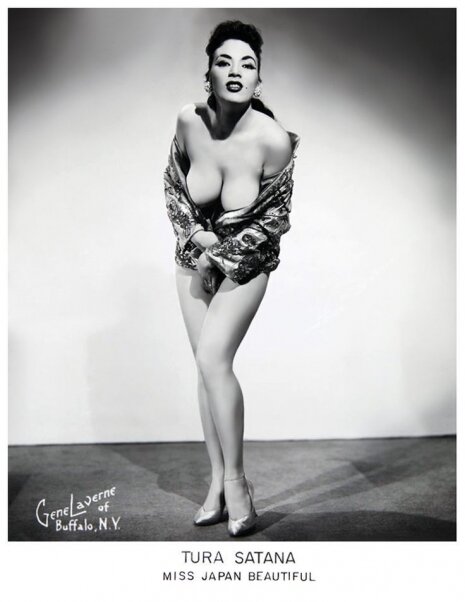Words by Roxy Bourdillon
In our brand new series, Trailblazers Of Tease, we celebrate groundbreaking erotic dancers from the past. First up, the awe-inspiring Tura Satana.
TW: This article contains references to sexual assault of a minor (CSA) and victim-blaming.
An Amazonian beauty in a black catsuit and leather gloves strides across the desert. She has long ebony hair and a cleavage that won’t quit. There’s a man cowering in front of her and he’s right to be scared.This ball-busting femme fatale is none other than murderous, go-go-dancing gang leader Varla from Russ Meyers’ cult 1965, hit Faster, Pussycat! Kill! Kill! And the woman playing her is just as tough.
Whether onstage or screen, burlesque legend and B-movie superstar, Tura Satana, gives a whole new meaning to the term “kickass”.
Tura Luna Pascual Yamaguchi was born on 10th July 1938 in Hokkaidō, Japan. Showbiz was always in her blood. Her dad was a silent movie actor of Japanese-Filipino descent, while mum was a circus contortionist of Cheyenne and Scottish heritage. When Tura was four, the family relocated to America in search of a better life, but soon after their arrival, the attack on Pearl Harbour happened and America went to war with Japan.
Tura was separated from her mother and locked up with her father and brother in an internment camp in California. When the conflict ended they moved to Chicago, but their troubles were far from over. At school and in the streets, Tura was subjected to racist bullying on a daily basis.
Then things got even worse. At nine years old, she was attacked by five men who raped her and left her in an alleyway. They were arrested, but the judge let them off. Rumour has it, he accepted a $1000 bribe. Meanwhile in a horrific case of victim-blaming, Tura was punished for “enticing” the men. Classified as a juvenile delinquent, she was sent to reform school. In her biography she writes, “Everyone blames you for being raped, not the rapist.”
Filled with rage, she founded an all-girl gang, The Angeles. They sound awesome. Dressed in matching leather motorcycle jackets, they patrolled the neighbourhood to protect local girls from male predators. Their initiation ritual? Piercing their ears with a knife, no ice allowed. It was around this time that Tura concocted a plan to seek vengeance on her attackers. Throwing herself into martial arts training, she became a black belt in karate and a green belt in aikido. “I made a vow to myself that I would someday, somehow, get even with all of them.” Over the next few years she tracked each of them down and exacted her revenge. In a 2009 interview with Daily Xtra she explains, “I learned to be tough because of what life kept handing me. I could either go down for the count or I could get up and kick ass.”
After a brief teenage marriage arranged by her parents, Tura decided to take control of her future. She escaped to LA with a fake ID and a fabulous new surname. Yep, Tura Satana was her legal name. At only 15 years old, she landed a waitressing job at the Tropicana Club and one fateful night when a dancer called in sick, she was asked to fill in. She credits her burlesque career with showing her that “not all of life sucks”.
Revelling in the thrill of a live audience, she began stripteasing as “Galatea, the Statue that Came to Life”
Romance-wise, things were looking up too. She dated several famous men, including Frank Sinatra and Elvis Presley. According to Tura, she taught Elvis-The-Pelvis some of her best dance moves and showed him how to French kiss, which, as you can imagine, left him all shook up. Naturally, Elvis couldn’t help falling in love with her. But when he popped the question, Tura told him she simply couldn’t love him tender. She did keep the ring though. After all, it was a three carat solitaire diamond.
As a woman of colour, she was often met with hostility from audiences, but she said they mostly warmed up to her once they saw her spellbinding abilities. As an entertainer, Tura embodied a winning combination of sensuality and strength.
With a new moniker, “Miss Japan Beautiful”, she became known for her tassel-twirling prowess and the way she incorporated martial arts moves into her dancing. Her favourite act was a Geisha-inspired number, which used original music and a giant Buddha statue. Tura strutted onstage, resplendent in a Japanese kimono and enormous headdress. After captivating the crowds with her erotic dancing, for her grand finale she took a small hara-kiri knife and pretended to commit suicide.
It wasn’t long before Hollywood came calling. Her first acting gig was playing sex worker, Suzette Wong, in the 1963 comedy, Irma La Douce. She went on to appear in numerous films, but her most famous role of all was leather-clad vixen, Varla. On Faster, Pussycat! Kill! Kill! Tura served serious attitude, choreographed fight scenes and did all her own stunts. If the idea of three buxom broads beating the crap out of men appeals to you, then heat up the popcorn and settle down for a truly iconic slice of camp cinema herstory.
For Tura, this film was more than just a romp. It was a chance to release some of the demons she had been carrying with her for so long. "I took a lot of my anger that had been stored inside of me for many years and let it loose."
The film solidified Tura’s place in pop culture forever. It also broke through many boundaries, subverting racial and gender stereotypes and showing that women and people of colour could be powerful too.
The inspirational performer died of heart failure aged 72 in February 2011, but her legacy lives on to this day. She paved the way for burlesque dancers of colour and showed cinema-goers worldwide that women could be as resilient and self-reliant as men.




